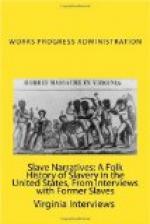“I taught school at Conway in Faulkner County, and joined the ministry as a local preacher, in 1896. I moved from there to White County and taught in Searcy one term. Taught at Beebe ten years. Married again in 1898—Annie Day. I taught at Beebe and lived in White County. Then I bought me a home at Higginson, and went into the ministry solely. I left Higginson and taught and pastored seven years at Des Arc. I know practically everybody in Des Arc. I was thinking today about writing Brick Williams. He is the son of old man Williams, the one you know I think. Then I come to what is called Sixteen Section three miles from Galloway and taught there seven years and pastored. I presided too as Elder some of those years—North Little Rock District. Then I went back and pastored there and taught at West Point, Arkansas four years. Then I pastored at Prescott and was on the Magnolia District as Presiding Elder two years. Then I presided over the North Little Rock District again. Pastored St. Luke Circuit in southwest part of Arkansas below Washington. Then I built a church at Jonesboro. I pastored twenty-nine years altogether, built five churches, and have been responsible for five hundred conversions.
“I think the prospects of the country and the race are good. I don’t see much dark days ahead. It is just a new era. You are doing something right now I never saw done before in my life. Even when they had the census, I didn’t see any colored people taking it.
“I don’t get any assistance in the form of money from the government. I have been trying to get it but I can’t. Looks like they cut off a lot of them and can’t reach it. Won’t let me teach school. Say I am too old for WPA teaching. Superannuate me in the church, and say I’m too old to preach, and still I haven’t gotten anything from my church since last January. I get some commodities from the state. I belong to the C.M.E. Church. I have lived in this community twenty-five years.”
Interviewer’s Comment
Hanging on the wall was the old man’s diploma from the Mississippi State Normal School for colored persons. It was dated May 30, 1888, and it bore the signatures of J.R. Preston, State Superintendent; E.D. Miller, County Superintendent (both members of the Board of Directors); J.H. Henderson, Principal; Narcissa Hill and Maria Rabb, faculty members.
Interviewer: Mrs. Bernice Bowden
Person interviewed: George Brown
Route
4; Box 159, Pine Bluff, Arkansas
Age: 84
“Yes’m, I was born in slavery times. I was born in 1854. How old does that leave me?
“No ma’am, I wasn’t born in Arkansas, born in Alabama.
“Jim Hart was my white folks. Good to me? I’d rather let that alone. Plenty to eat? I’ll have to let that alone too. I used to say my old missis was ‘Hell a mile.’ Her name was Sarah. She was a Williams but she married Jim Hart. They had about a hundred and seventy head, little and big together.




